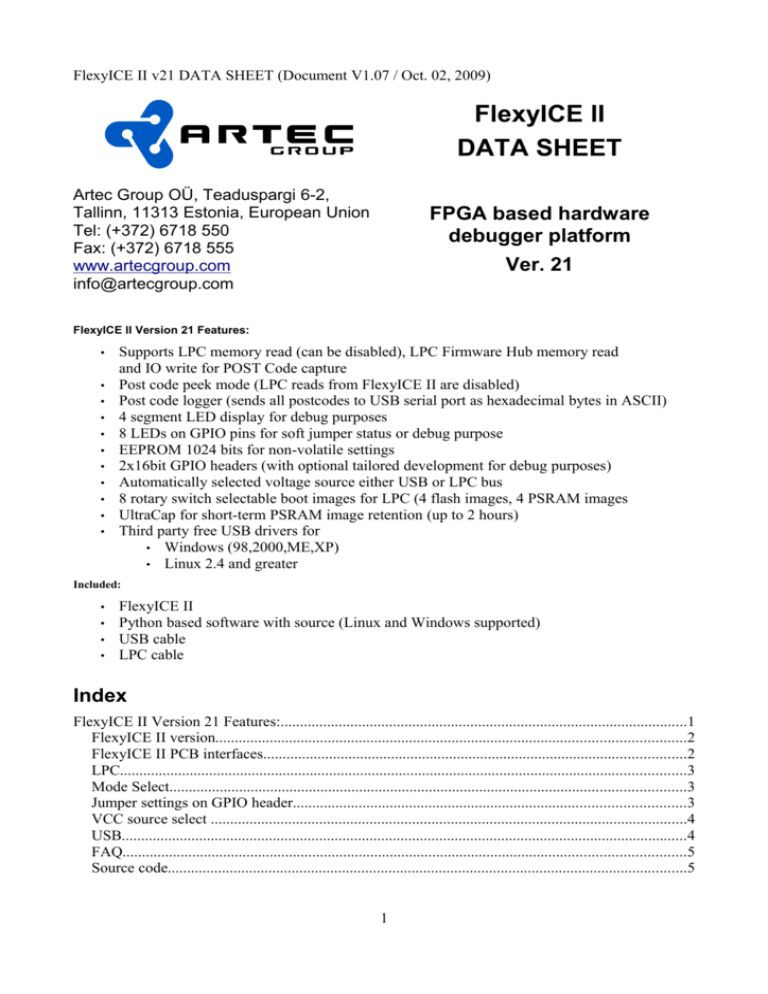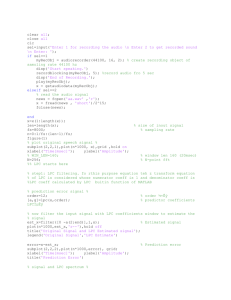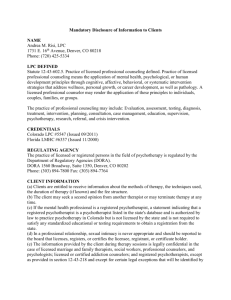FlexyICE II DATA SHEET
advertisement

FlexyICE II v21 DATA SHEET (Document V1.07 / Oct. 02, 2009) FlexyICE II DATA SHEET Artec Group OÜ, Teaduspargi 6-2, Tallinn, 11313 Estonia, European Union Tel: (+372) 6718 550 Fax: (+372) 6718 555 www.artecgroup.com info@artecgroup.com FPGA based hardware debugger platform Ver. 21 FlexyICE II Version 21 Features: • • • • • • • • • • • Supports LPC memory read (can be disabled), LPC Firmware Hub memory read and IO write for POST Code capture Post code peek mode (LPC reads from FlexyICE II are disabled) Post code logger (sends all postcodes to USB serial port as hexadecimal bytes in ASCII) 4 segment LED display for debug purposes 8 LEDs on GPIO pins for soft jumper status or debug purpose EEPROM 1024 bits for non-volatile settings 2x16bit GPIO headers (with optional tailored development for debug purposes) Automatically selected voltage source either USB or LPC bus 8 rotary switch selectable boot images for LPC (4 flash images, 4 PSRAM images UltraCap for short-term PSRAM image retention (up to 2 hours) Third party free USB drivers for • Windows (98,2000,ME,XP) • Linux 2.4 and greater Included: • • • • FlexyICE II Python based software with source (Linux and Windows supported) USB cable LPC cable Index FlexyICE II Version 21 Features:.........................................................................................................1 FlexyICE II version.........................................................................................................................2 FlexyICE II PCB interfaces.............................................................................................................2 LPC..................................................................................................................................................3 Mode Select.....................................................................................................................................3 Jumper settings on GPIO header.....................................................................................................3 VCC source select ...........................................................................................................................4 USB..................................................................................................................................................4 FAQ.................................................................................................................................................5 Source code......................................................................................................................................5 1 FlexyICE II v21 DATA SHEET (Document V1.07 / Oct. 02, 2009) FlexyICE II version FlexyICE II version number can be seen on the postcode byte if reset button is held down while USB cable is connected or FlexyICE II is connected to a host system by LPC bus. This document deals with FlexyICE II version 21. Additions from FlexyICE to FlexyICE II: LPC Firmware Hub read capability and disable jumper to disable the new mode. Post code peek mode (post code IO writes are shown but read requests are ignored) Performance estimates for FlexyICE II: – – (PSRAM area Linux 4096K write time 4s, read time 10s) (Flash area Linux 4096K write time 59s includes erase time 27s, read time 10s) (PSRAM area Windows XP 4096K write time 7, read time 7s) (Flash area Windows XP 4096K write time 2m37s includes erase time 27s , read time 7s) FlexyICE II PCB interfaces Extension header NC OPT5 OPT3 OPT1 BYTE BLASTER II NC OPT4 OPT2 OPT0 Flash LPC header VCC3 CLK LFRAME LAD2 LAD0 GND DEV_PRESENT LAD3 LAD1 RESETX FPGA LPC header pin 1 RAM Mode select rotary switch Reset button USB mini B Post code byte Power LED 8 debug LEDs 4MB mode RED LED Drawing 1: PCB top layout 2 FlexyICE II v21 DATA SHEET (Document V1.07 / Oct. 02, 2009) LPC LPC header provides 7 IO pins used for LPC signal (see FlexyICE II schematic) and DEV_PRESENT signal driven low to indicate that FlexyICE II is connected. By default 1MB of flash can be accessed over LPC bus (highest MB of 4 MB available in each mode configuration). This can be changed by IO command to full 4 MB. LPC IO write to address 0x0088 data 0xF4 turn on 4MB addressing LPC IO write to address 0x0088 data 0xF1 turn off 4MB addressing LPC IO write to address 0x0080 will be displayed on Post code byte Mode Select Mode select rotary switch is intended for internal image selection from Flash memory divided into 4 separate 4 MB sections or PSRAM also divided into 4 separate 4 MB sections. PSRAM provides shot-term storage when power is removed with fast write and read capability. With approximately 99% charged capacitor PSRAM content is maintained over 2h. (The charge time to 99% of capacitor depends on initial charge, but should not be longer than 2 minutes) Jumper settings on GPIO header The GPIO header J403 with jumper status LEDs is by default used for jumpers. Pin pairs 34, 5-6 and 7-8 from the header are used as jumper pins. Pin pair 1-2 is 3.3V and can't be used as a jumper pins. 3.3 V Vcc Pin pair 1,2 Pin pair 5,6 Post code peek mode 5 V Vcc, Pin 1 on J404 GND,Pin pair 19,20 GND, Pin 2 on J404 Pin pair 7,8 Post code logger Pin pair 3,4 Enable LPC Memory read Jumper on header pin pair: – 3-4 is “Enable LPC Memory read” this is legacy option to allow booting from devices that don't support LPC Firmware Hub read cycles although LPC Firmware read cycles are also responded in this configuration. If pins 1-2 are left open only LPC Firmware read cycles are responded. – 5-6 is Post code peek mode enable jumper. In this mode FlexyICE II is not a memory device and accepts only IO write commands to addresses 0x0080 (post code) and 0x0088 (memory size command register) the post code bytes are displayed on lower two segments of 4 segment display. – 7-8 is Post code logger mode enable jumper. In this mode all post codes are sent to USB serial port. Open serial terminal to the FTDI USB serial port with settings: baud=115200, data=8 bit, parity=none, stop=1 bit, Flow=none. Post codes are displayed in hexadecimal format 16 bytes 3 FlexyICE II v21 DATA SHEET (Document V1.07 / Oct. 02, 2009) per line (\r\n as line separators) all bytes are prefixed by “x” and byte separator is space character. For example: “x80 x11 x55 x10 x80 x11 x55 x10 x80 x11 x55 x10 x80 x11 x55 x10\r\n” The 4 segment display in this mode will show internal FIFO byte count. If the byte count reaches “x1F40” the FlexyICE II will start to flow control LPC IO write cycles to avoid data loss. This may affect boot time if post code IO writes are heavily used (no data loss should occur). GPIO pins are platform pins that are not used in the standard LPC version of the FlexyICE II but are target for tailored development for specific functions. VCC source select FlexyICE II has automatic VCC source selection. When USB cable is used at the same time with target board LPC connection, the power will be drawn from USB cable. When target board is used as voltage source the POR (power on reset) time along with the FPGA configuration time (~ 30 ms) has to be taken into account when using the FlexyICE II as a boot device. It is recommended to use target board reset to initiate clean boot after power up. USB USB interface is used to program FlexyICE II flash or read back flash content. This can be done by Artec USB FlexyICE II programming utility. Usage: Write file dongle.py [-vq] -c <name> <file> <offset> Readback file dongle.py [-vq] -c <name> [-vq] -r <offset> <length> <file> Options: <file> <offset> When file and offset are given file will be written to device file: File name to be written to device offset: Specifies data writing starting point in bytes to 4M window For ThinCan boot code the offset = 4M - filesize. To write 256K file the offset must be 3840K -c <name> name: Indicate port name where the USB Serial Device is COM port name in Windows or Linux Examples: COM3,/dev/ttyS3 See Device Manager in windows for USB Serial Port number -v Enable verbose mode. Displays more progress information -q Perform flash query to see if device flash is responding -r <offset> <length> <file> Readback data. Available window size is 4MB offset: Offset byte addres inside 4MB window. Example: 1M use M for MegaBytes, K for KiloBytes, none for bytes 4 FlexyICE II v21 DATA SHEET (Document V1.07 / Oct. 02, 2009) use 0x prefix to indicate hexadecimal number format. length: Amount in bytes to read starting from offset. Example: 1M use M for MegaBytes, K for KiloBytes, none for bytes file: -e Filename where data will be written Erase device. Erases Full 4 MegaBytes Board test options: -t Marching one and zero test. Device must be empty To test device erase the flash with command -e Enables device memory tests to be executed by user -b Leave flash blank after test. Used with option -t Examples: dongle.py -c COM3 loader.bin 0 dongle.py -c /dev/ttyS3 boot.bin 3840K dongle.py -c COM3 -r 0x3C0000 256K flashcontent.bin USB programming utility can address all of the 4 MB available in any mode that is selected. It must be remembered that only 3072KB to 4096 KB in each mode configuration is directly accessible over LPC and is repeated in LPC memory address space (x86 legacy 1M window) without using the 0xF4 command first (see LPC paragraph). FAQ Q: Why does the FlexyICE II give error code when opening serial port in Ubuntu Linux? A: If you use Ubuntu, make sure to uninstall brltty (apt-get remove brltty --purge) before you hook up the FlexyICE II; otherwise it will hijack the FlexyICE II and you won't be able to talk to it. Brltty is a software Braille terminal. (http://www.coreboot.org/Artecgroup_programmable_LPC_dongle) Source code Source SVN repository is available at http://www.opencores.org/project,artec_dongle_ii_fpga Contains: • Python USB application source code • VHDL LPC slave (supporting IO write and Memory read) • VHDL Flash Waveform generator • VHDL FTDI parallel interface to on-board flash (supports block write) • VHDL Scanning LED segment display coder • Project files with pin location constraints (for Altera QuartusTM Web Edition) 5






